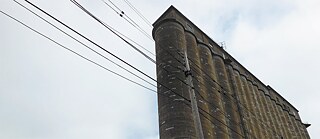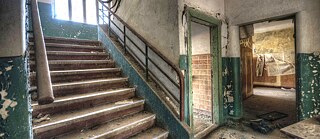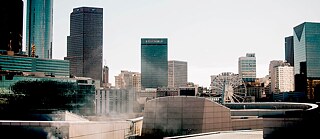Surreal architecture on Lake Erie
The Colossi of Buffalo
At one time, Buffalo, New York, was the world’s foremost grain port. The old grain silos are awesome colossi, made of steel and reinforced concrete. Now, the silos are being rediscovered and repurposed — a trend in similar former industrial areas in Europe, South America, and South Africa.
Listen to this episode: Apple Music | Spotify | Download
This episode is by Alex van Oss. Alex has been a reporter and producer for four decades, for NPR and other networks. From 2003 to 2014, he coordinated Caucasus Area Studies for the U.S. State Department’s Foreign Service Institute. Alex once played the part of German playwright Bertolt Brecht in a high school theater production. In this episode, Alex chats with an architect that specializes in silos and those behind the abandoned granaries’ renovations. The songs “Cafeteria” and “Dance of the Excavators” come from Torn Space Theater. The photo for this episode was taken by Alex himself. It shows the Marine A silo in Buffalo, New York. In addition to this episode, Alex produced the episodes “How Buildings Mean” and “The Library and the Book.”
Transcript
Alex van Oss: All over the world, in Europe, South Africa, and South America ... old industrial buildings are being put to startling new uses. In the United States, the old Rust Belt industrial city of Buffalo, New York, is leading the way — with grain silos. I’m Alex van Oss. The next time you eat a bowl of cereal for breakfast, like Cheerios or shredded wheat — think of Buffalo. At one point, it was the world’s largest grain port.
This is an old boat song from the 1800s, sung on the Great Lakes — when millions of tons of cereal grain were shipped from the Midwestern prairies, over Lake Erie, to Buffalo, New York. But what to do with it — all that wheat, oats, and rye when it got to Buffalo? Well, first of all, you had to store it, hoist and dump it into silos — great wooden, or steel, or reinforced concrete cylinders. Think of vertical tons of grain, piled into towers along the meandering Buffalo River. Enough grain stored in them for, say, 3 billion loaves of bread.
The grain is gone now, pretty much — but the silos remain ... rusting. Bleak in the snow, awesome under the moon. To some, they look like Egyptian ruins — empty, with few windows, acres of vertical concrete. Like huge ships, or elephants standing alone, or clustered, unused. As if waiting for something.
Lynda Schneekloth: Buffalo, today, has 14 standing elevators. So, two working, 14 standing.
Alex van Oss: Lynda Schneekloth is a former professor at the University of Buffalo’s School of Architecture and Planning. Silos are her specialty.
Lynda Schneekloth: For a while, there was the attitude in the city of Buffalo: Just tear them down, tear them down. I think the reason that they didn’t get torn down is that they were horribly expensive to tear down. The river was quite contaminated. Most people could see the grain elevators but would have no idea how you would get to them. And so I think that their sort of ... isolation, protected them for many years.
Alex van Oss: Many university faculty and students became fascinated by the silos. And 100 years ago so did certain crucial German and Swiss designers: pioneers and giants of the ‘International’ style of architecture.
Hadas Steiner: My name is Hadas Steiner. I’m an associate professor of architecture at the University of Buffalo. Photographic evidence of grain elevators came to the attention of Walter Gropius, and Le Corbusier saw them. So, Le Corbusier thought the silos were so perfect of an illustration of his ideas that he wanted everyone else to believe it. And he even doctored the images, to make them more perfectly pure, prismatic, cylindrical than they even were.
Alex van Oss: During the 20th century, grain shipments started to bypass Buffalo, and the silos gradually closed. Many Buffalonians no longer knew about them. They were hard to get to and derelict and fenced off by the lake. You had to go all the way down Main Street, hook over to Michigan Avenue, continue down Ohio Street, then cross a bridge — and finally, here we are at the end at the back of nowhere, surrounded by silos.
❡
Alex van Oss: What would this place have sounded like, before you were born? Say, 120 years ago?
Rick Smith: Well, I think you’d have lake freighters coming in by water. You’d have the dust collectors running. You’d have the marine legs operating, which are the conveyors that take the grain up then out of the boats. You’d have the rail cars moving, you’d have the mills. You know ... Robin Hood Flour was made in one of the mills, and Occidental Flour in another one of the mills. It’d be quite an active spot.
Alex van Oss: Rick Smith heads an old company called Rigidized Metal. Eleven years ago, he wanted better access to his office and factory. And so he bought 150 acres of surrounding land, and with it, four deserted silos as well. What to do with them? Store corn? Maybe make biofuel and ethanol? Well, that didn’t work out ... but then, in 2011, Rick Smith got a call from the university.
Rick Smith: Lynda Schneekloth and UB [University of Buffalo], we had the National Preservation Trust come to town. And it was a perfect opportunity for us to show off our Le Corbusier and Mendelssohn’s modernism architecture to the rest of the country. So we hosted a party down here, and that’s where we sort of said, you know, it works — it could be a place that we should open to the public.
Alex van Oss: That party was such a success, it led to the development of what’s called ‘Silo City’ — part of the complete rethinking of Buffalo’s old port and waterfront. Now it’s a tourist destination. Brad Hahn is executive director of a new tour group, called Explore Buffalo.
Brad Hahn: The growth that we’ve had over the past five years has been tremendous. The interest that people have in our city ... we’ve gone from about 6,000 people taking a tour in 2014, five years ago, to this year — we’re going to have over 20,000 people taking a tour with us.
Alex van Oss: Many visitors have fun getting to the silos by kayak, along the river, or by land.
Brad Hahn: At Silo City, we’ve got a pair of tours that we offer. We do go inside several of the grain elevators. Our other tour that we offer at Silo City is our ‘vertical tour’ to the top of the silos. There are certainly spots there that we don’t want people going. So we limit the group to a small number of people. And we ensure that people don’t wander away. We have volunteers on that tour, specifically called chaperones, and they’re essentially the sheepdogs who ensure that nobody wanders off to a spot where the floor is crumbling or something like that. But on that tour, where we’re going up to the top of those buildings — that’s about 150 feet — you really see all of the interior workings of those complexes when you’re at the top. Along with some spectacular views of the waterfront, of Lake Erie, of Buffalo ... and you can even see up to Niagara Falls on a clear day.
[SOUND: SYNTHESIZED SOUND-BED FOR A TORN SPACE THEATER EVENT]
Alex van Oss: All kinds of silo events now take place because of the unique acoustics. There are concerts and poetry readings, and also performance art by Torn Space Theater Company. Elsewhere among silos and the waterfront, there’s a new hockey rink, a beer hall, a condominium ... but Silo City purposely maintains its original industrial grit. It’s all a bit apocalyptic. Hollywood’s filmed there, for three movies. The silos loom over you and are not exactly homey. Unless you’re someone like Jim Watkins, known as ‘Swanee Jim,’ after the local Swanee Bar.
Jim Watkins: We’re sort of at the apex of the wedge. In terms of one contiguous area, this has the largest grain capacity that’s known. It totals 16 million bushels.
Alex van Oss: Jim Watkins is the caretaker and site manager for Silo City. He lives in a shack here, along with Gonzo, his affectionate pit bull.
Jim Watkins: So, this is Marine A. This was built in 1925.
Alex van Oss: How high is this?
Jim Watkins: These are 120 feet. And again, it’s a 30-foot diameter.
Alex van Oss: Though cleaned up, it’s tricky walking ... and sobering to think of working conditions here long ago. The older wooden silos could burn down, and steel ones buckle from those tons of stored grain piled up 120 feet. Or the dust could explode, or the grain itself could cave in and collapse — creating a vacuum that might suck in the whole top of the silo, along with any unfortunate workers nearby ...
Jim Watkins: We have two other people that come down and perform every year. And they took turns, actually, coming inside. Because it gets even a longer resonance time, and it changes. You see, that’s the magic of the site. There are all these different variables people can play with.
Alex van Oss: It’s good to get outside again, and back at the shack, and sit awhile with Swanee Jim and Gonzo. Watkins is happy the silos are being put to new use. But there’s something else, he says ... this place, once so busy, is now returning to nature. And there’s another thing that keeps him living here, taking care of this particular spot — because it’s special, he says ... and apparently always has been.
Jim Watkins: There is something about the site, and I think it actually predates these silos and elevators. But there an awful lot of people that get ... when they come here, there’s a certain spiritualness to it. A great friend of ours — Kevin ‘The Horse Thief’ McCarthy — had one of the best phrases for it. He had no doubt that the Native Americans, probably prior to the Senecas — there was a tribe here called the Neutrals. And where the highway is, back over here, you had 50- to 60-foot-high sand dunes there. In the summertime, where else would one rather be? You’re by the lake, so you’re going to have a bit of a breeze to be eased from the bugs. You’re going to have fishing and game. The river around half of this site has less than 90-degree bend, and in some cultures, those are considered power centers. So there’s a spirituality here, as the Horse Thief would have said. And then we came along and built these grandes dames of structures to protect the sacredness of what preceded. We are merely the current stewards of the site.
[TORN SPACE THEATER SOUND-BED ... ]
Jim Watkins: Jim Watkins at Silo City, Buffalo, New York.
Alex van Oss: And for THE BIG POND, this is Alex van Oss.
[LONG FADING CUT OF TORN SPACE THEATER SOUND]







